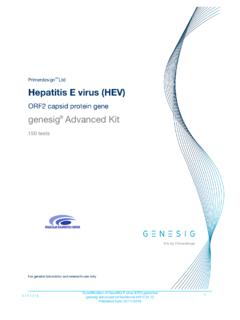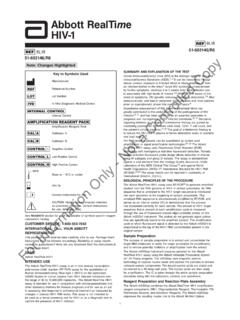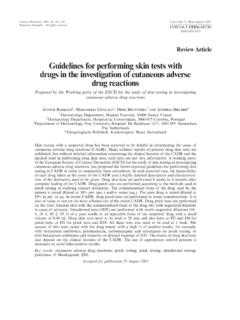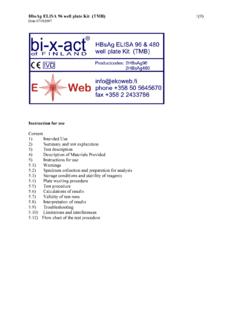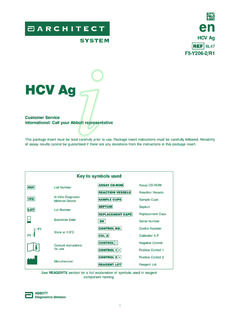Transcription of OECD GUIDELINE FOR THE TESTING OF CHEMICALS
1 OECD/OCDE 490 Adopted: 28 July 2015 1 OECD, (2015) You are free to use this material for personal, non-commercial purposes without seeking prior consent from the OECD, provided the source is duly mentioned. Any commercial use of this material is subject to written permission from the OECD. OECD GUIDELINE FOR THE TESTING OF CHEMICALS In Vitro Mammalian Cell Gene Mutation Tests Using the Thymidine Kinase Gene INTRODUCTION 1. The OECD Guidelines for the TESTING of CHEMICALS are periodically reviewed and revised in the light of scientific progress, regulatory needs and animal welfare. The mouse lymphoma assay (MLA) and TK6 test using the thymidine kinase (TK) locus were originally contained in Test GUIDELINE 476 adopted in 1984 and revised in 1997, based on scientific progress made to that date.
2 Subsequently, the MLA Expert Workgroup of the International Workshop for Genotoxicity TESTING (IWGT) has developed internationally harmonized recommendations for assay acceptance criteria and data interpretation for the MLA (1) (2) (3) (4) (5), and these recommendations are incorporated into this new Test GUIDELINE (TG 490). TG 490 is written for the MLA and, because it also utilizes the TK locus, the TK6. While the MLA has been widely used for regulatory purposes, the TK6 has been used much less frequently. It should be noted that in spite of the similarity between the endpoints the two cell lines are not interchangeable and regulatory programs may validly express a preference for one over the other for a particular regulatory use.
3 For instance, the validation of the MLA demonstrated its appropriateness for detecting not only gene mutation, but also, the ability of a test chemical to induce structural chromosomal damage. This Test GUIDELINE is part of a series of Test Guidelines on genetic toxicology. A guidance document is under preparation and will provide succinct and useful guidance to users of these Test Guidelines. 2. The purpose of the in vitro mammalian cell gene mutation tests is to detect gene mutations induced by test CHEMICALS . The cell lines used in these tests measure forward mutations in reporter genes, specifically the endogeneous thymidine kinase gene (TK for human cells and Tk for rodent cells, collectively referred to as TK in this GUIDELINE ).
4 This GUIDELINE is intended for use with two cell lines: the L5178Y TK+ mouse lymphoma cell line (generally called L5178Y) and the TK6 human lymphoblastoid cell line (generally called TK6). Although the two cell lines vary because of their origin, cell growth, p53-status, etc., the TK gene mutation tests can be conducted in a similar way in both cell types as described in this GUIDELINE . 3. The autosomal and heterozygous nature of the thymidine kinase gene enables the detection of viable colonies whose cells are deficient in the enzyme thymidine kinase following mutation from TK+/- to TK-/-. This deficiency can result from genetic events affecting the TK gene including both gene mutations (point mutations, frame-shift mutations, small deletions, etc.)
5 And chromosomal events (large deletions, chromosome rearrangements and mitotic recombination). The latter events are expressed as loss of heterozygosity, which is a common genetic change of tumor suppressor genes in human tumorigenesis. 490 OECD/OCDE OECD, (2015) 2 Theoretically, loss of the entire chromosome carrying the TK gene resulting from spindle impairment and/or mitotic non-disjunction can be detected in the MLA. Indeed, a combination of cytogenetic and molecular analysis clearly shows that some MLA TK mutants are the result of nondisjunction. However, the weight of evidence shows that the TK gene mutation tests cannot reliably detect aneugens when applying standard cytotoxicity criteria (as described in this GUIDELINE ) and therefore, it is not appropriate to use these tests to detect aneugens (6) (7) (8).
6 4. In the TK gene mutation tests, two distinct phenotypic classes of TK mutants are generated; the normal growing mutants that grow at the same rate as the TK heterozygous cells, and slow growing mutants which grow with prolonged doubling times. The normal growing and slow growing mutants are recognized as large colony and small colony mutants in the MLA and as early appearing colony and late appearing colony mutants in the TK6. The molecular and cytogenetic nature of both large and small colony MLA mutants has been explored in detail (7) (9) (10) (11)(12 ). The molecular and cytogenetic nature of the early appearing and late appearing TK6 mutants has also been extensively investigated (13) (14) (15) (16 ).
7 Slow growing mutants for both cell types have suffered genetic damage that involves putative growth regulating gene(s) near the TK locus which results in prolonged doubling times and the formation of late appearing or small colonies (17). The induction of slow growing mutants has been associated with substances that induce gross structural changes at the chromosomal level. Cells whose damage does not involve the putative growth regulating gene(s) near the TK locus grow at rates similar to the parental cells and become normal growing mutants. The induction of primarily normal growing mutants is associated with substances primarily acting as point mutagens.
8 Consequently it is essential to count both slow growing and normal growing mutants in order to recover all of the mutants and to provide some insight into the type(s) of damage (mutagens vs. clastogens) induced by the test chemical (9) (11) (17) (1 8). 5. The Test GUIDELINE is organized so as to provide general information that applies to both MLA and TK6 and specialized guidance for the individual tests. 6. Definitions used are provided in Annex 1. INITIAL CONSIDERATIONS AND LIMITATIONS 7. Tests conducted in vitro generally require the use of an exogenous source of metabolic activation. The exogenous metabolic activation system does not entirely mimic in vivo conditions.
9 8. Care should be taken to avoid conditions that could lead to artifactual positive results ( possible interaction with the test system) not caused by interaction between the test chemical and the genetic material of the cell; such conditions include changes in pH or osmolality, interaction with the medium components (19) ( 20) , or excessive levels of cytotoxicity (21) (22) (23 ). Cytotoxicity exceeding the recommended top cytotoxicity levels as defined in paragraph 28 is considered excessive for the MLA and TK6. In addition, it should be noted that test CHEMICALS that are thymidine analogues, or behave like thymidine analogues can increase the mutant frequency by selective growth of the spontaneous background mutants during cell treatment and require additional test methods for adequate evaluation (24).
10 9. For manufactured nanomaterials, specific adaptations of this Test GUIDELINE may be needed but are not described in this Test GUIDELINE . 10. Before using the Test GUIDELINE for TESTING a mixture to generate data for an intended regulatory purpose, it should be considered whether, and if so why, it may provide adequate results for that purpose. Such considerations are not needed, when there is a regulatory requirement for TESTING the mixture. OECD/OCDE 490 OECD, (2015) 3 11. Mutant cells deficient in thymidine kinase enzyme activity because of a mutation TK+/- to TK-/- are resistant to the cytostatic effects of the pyrimidine analogue trifluorothymidine (TFT).
